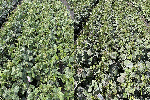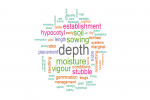In south-west New South Wales, the irrigated Mayrung National Variety Trials site near Blighty attracted plenty of interest from southern growers keen to assess the range of new high-yielding wheat varieties on offer
On an overcast and showery morning in October, more than 50 growers gathered at the Mayrung irrigated National Variety Trials (NVT) site in southern New South Wales. The drawcard was a range of new high-yielding wheat varieties suitable for irrigated and dryland farming systems.
NSW Department of Primary Industries and Regional Development (DPIRD) technical specialist Peter Matthews shared the latest NVT performance results while growers inspected each cultivar for yield potential, disease susceptibility, canopy structure, height and lodging tolerance.
The event, organised by Southern Growers’ Stephanie Chappell, was held on Jake Plattfuss’s family farm near Blighty, about 30 kilometres from the NSW–Victoria border.
Figure 1: 2024 Mayrung NVT by numbers.

Trial background
Mr Plattfuss said the NVT 2024 site was sown onto a 2023 canola stubble that followed a failed 2022 faba bean crop.
“That failed faba bean crop produced 20 tonnes of biomass and 0.5 tonnes a hectare of grain,” he said. “It likely put 300 to 400 kilograms/ha of nitrogen into the system, leaving plenty of nitrogen for the following canola and wheat.”
- The 2024 Mayrung NVT had:
- 150kg/ha of monoammonium phosphate (MAP) and 100kg/ha of urea applied at sowing;
- 500kg/ha of urea top-dressed over two applications;
- four fungicide sprays to defend against disease;
- 40 to 50 millimetres of irrigation water in autumn and 180mm in spring.
- By 19 October, 370mm of rainfall had fallen, 8mm below the median.
Rust pressure
Mr Plattfuss said stripe rust pressure was high, and the Sunmaster crop surrounding the trial site had “copped a flogging” at early grain fill, when the variety’s adult plant resistance should have kicked in.
For a moderately resistant to moderately susceptible (MR-MS) variety, Mr Matthews said the adult plant resistance should kick in at Zadoks cereal growth stage 39.
“However, the high level of plant-available nitrogen likely means the variety’s adult plant resistance did not kick in until head emergence,” he said.
Despite the disease pressure, Mr Plattfuss said yield potential was promising because of soft spring conditions with minimal heat and plenty of sunlight.
At the event, Mr Matthews said the NVT provided a sound basis for deciding which wheat varieties to sow.
Variety improvement is one of the only defences against rising inflation,” he said. “Growers need to find a one to five per cent improvement in yield annually just to meet the yearly rising cost of inputs.
Performance results
With support from Australian Grain Technologies’ James Whiteley and Baker Seed Co’s Aaron Giason, Mr Matthews discussed the advantages and disadvantages of early-season, main-season and durum wheat varieties.
Of the early-season milling wheat varieties sown on 20 April 2024, Mr Matthews said NVT data from 2019 to 2023 had demonstrated Brighton, Genie, Leverage, Sundancer and LRPB Majorwere high-yielding options.
Of the main-season milling wheat varieties sown on 9 May, he said NVT results from 2019 to 2023 showed the high-yielding options were Shotgun, Tomahawk CL Plus, Sunmaster, LRPB Matador, RGT Ponsford, Ironbark and Sunblade CL Plus.
Mr Matthews said if growers wanted an Australian Prime Hard (APH) variety for irrigated production, Sunmaster was well adapted and performed well in both variety trials and growers’ paddocks.
“If you want an Australian Hard (AH) variety, the new cultivar Shotgun topped the main-season wheat trial on Mr Plattfuss’s farm in 2023, yielding 8.5t/ha when sown on 2 June.”
While no NVT results were available for first-time entry Boa, growers were encouraged to monitor the new variety’s performance as a quick-to-mid-maturity wheat for high-production irrigated systems. This was because it was bred from the popular irrigated wheat variety LRPB Cobra.
Durum wheats
Mr Matthews said DBA Vittaroi was the benchmark for grain yield, canopy height and lodging tolerance among the durum wheat varieties.
“If you’re looking for a high-yielding variety and can manage your crop canopy, the best option is Westcourt,” he said. “However, it’s not quite as well adapted to irrigation as DBA Vittaroi.”
He said durum wheat was very susceptible to Fusarium crown rot. Accordingly, rotational management with break crops, effective weed control to remove grass weeds in rotation crops and reducing cereal stubble carryover would help minimise the risk.
He also noted that a new seed treatment from Syngenta called Victrato®, waiting for final registration, had shown in research trials to be beneficial in reducing Fusarium crown rot yield losses in wheat and would be a great addition to growers’ tool bags.
Capacity building
As a service provider to the NVT, Mr Matthews oversees 127 trials across eight crops and 27 NSW locations. This requires five technical staff, four field trial managers, and a logistics and grain quality assessment officer.
“Generally, the technical staff that come through my program find the NVT an excellent opportunity to develop their crop research and agronomy skills,” he said.
“They understand how to run research trials across multiple sites and apply their agronomy expertise to maximise yields.”
National Variety Trials results
National Variety Trials (NVT) results from single sites take 21 days from the end of harvest to be published on the NVT website.
- Before the trial results are released, biometricians analyse them and plant breeders review them.
- Multi-environment trial (MET) results are the most accurate indicator of future variety performance.
- MET results take about 30 days after the harvest of the final trial to be uploaded to the NVT Long Term Yield Reporter.
- Anyone can subscribe to receive notifications when new trial results and MET data are available.
More information: Peter Matthews, peter.matthews@dpi.nsw.gov.au; Jake Plattfuss, jakeplatty@gmail.com; Stephanie Chappell, southerngrowersinc@gmail.com
Resources: National Variety Trials (NVT), nvt.grdc.com.au,
GRDC GroundCover™ Supplement Issue 142: National Variety Trials,
GRDC GroundCover™ Supplement Issue 174: Celebrating 20 years of NVT

























































